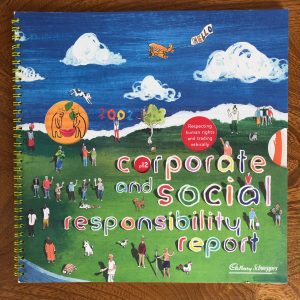Telling the year’s most important stories…
From Cadbury’s first ever corporate social responsibility (CSR) report to Mondelēz International’s Snacking Made Right ESG reports, from annual reports for Prosus to sustainability reports for Aldar – I have a long history of writing reports. Whether it’s annual reports, sustainability reports or ESG reports, these are invariably homes for my clients’ most important stories – their central sources of truth for the year. And they are great opportunities for me to get close to my clients in order to tell their key stories clearly and characterfully.
Here’s an extract from that first Cadbury CSR report, back in 2002:

Good news…
What’s good for the environment is good for our business
We are committed to sound and responsible environmental management in everything we do. This is a natural extension of the importance we place on protecting the world in which we live – in our own interests and in the interests of generations to come. It is also an integral part of achieving our objective to grow shareowner value over the long term. When you take into account the long term, you invariably find that what’s good for the environment is also good for consumers and good for business…
A group-wide policy since 1993
We adopted our Corporate Environment Policy in 1993. In 2000, in line with our undertaking to review and update the policy on a regular basis, we extended it to cover every aspect of our business – not only our manufacturing processes and the distribution, sale and consumption of our products, but also our raw materials and the ecosystems that provide them.
A set of targets to beat
Working to a group-wide Environmental Management System, we actively manage environmental issues and set detailed performance targets with a factory audit programme based on a three-year cycle.
We regularly measure ourselves against our performance targets and look for continuous improvement, particularly in the key areas of air emissions; water, energy and materials conservation; wastewater treatment; solid waste and packaging management; and soil and groundwater protection.
A part for everyone to play
Accountability for our environmental performance cascades down from the Board (who annually review our environmental performance), through individual business units to every individual. Each and every employee is responsible for some aspect of environmental performance – from the Principal Environmental Officer who reports directly to the Board’s Chief Operating Officer, to the factory worker charged with turning the lights off at the end of the shift.
Going green in Ireland
For the past few years the plant management team at Cadbury Ireland’s Rathmore Crumb Factory has been focusing on reducing the energy needed to make the chocolate crumb that goes into many of our brands. The more energy they save, the more money they save – what’s good for the environment is also good for the business.
As a first step they commissioned a comprehensive energy audit of the site. They then set about implementing the ideas generated by the report.
“One of the most interesting opportunities we found concerned our air compressor which could only provide compressed air at a constant pressure,” says Frank Hickey, Site Environmental Steward. “So we replaced it with a digitally controlled, speed-regulated machine which supplies exactly the pressure the system needs. As a result we have been able to run the system at a lower pressure and reduce its electricity consumption by 29%.”
“Our focus on energy consumption has also led us to review some of our day to day practices. We have reduced space heating times and temperatures, restricted unnecessary use of the cooling tower and revised the sequence in which the refrigeration units operate. All in all, since 1992 we have reduced the electricity needed to make each tonne of product by 22%, and the boiler energy required by 18%. And we haven’t finished yet!”
As well as cutting down on energy use, the team has also improved environmental standards in other areas: reducing factory waste by 39% and effluent strength discharge by 91% per tonne of crumb over the last nine years.
Making light work in the USA
We are constantly looking for opportunities to reduce the environmental impacts of our packaging without compromising on safety or consumer satisfaction. One of the ways we do this is to make the packaging lighter but still just as good at protecting the product.
At our Mott’s plant in Williamson, New York, we make applesauce and juice as well as other fruit products. Many of our products are sold in 36-ounce and 64-ounce recyclable plastic bottles. In the last two years, we have reduced the amount of corrugated cardboard needed to package these bottles by 75%. What’s the secret of all this weight loss? A clever combination of a cardboard tray with a shrink-wrap cover.
“By moving to ‘tray-and-shrink’, we have been able to reduce the overall weight of packaging leaving the factory during a typical year by almost 3,000 tonnes,” says Tom Freeman, Site Environmental Steward. “Both the card and the plastic wrap can be recycled after use. We also sell applesauce in a single-serve plastic cup sealed with a foil lid. We have recently reduced the weight of the foil used on each cup by 25%. These changes not only conserve resources, they also reduce the impact from transporting the packages because they weigh less – and, of course, they save us money.”